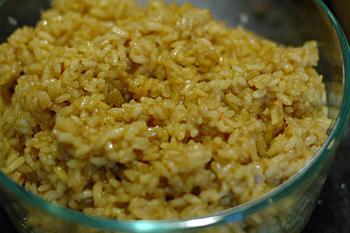For the longest time I have had the habit of eating rice only with chopsticks. Has to do with the proximity of a great Chinese eatery near our former residence in Rockville MD named “Far East”. Without the chopsticks one can explain my reluctance to consume any of the outstanding rice dishes that form part of the Italian and Spanish traditions rather than Japanese or Chinese.
The best example is the world-famous Risotto alla Milanese, a dish I have enjoyed only on rare occasions. However one must be aware that even with a set of chopsticks at hand the loose consistency of the authentic risotto renders them useless. So I have bypassed this delicacy more times than not. Pretty weird no?
Now however basking in retirement I have time to go back and revisit past eating habits and customs. Upon running across a risotto recipe on an Italian website recently I grabbed the opportunity to make up for lost enjoyments. This particular recipe for classic Risotto alla Milanese is straight from the source and brings back memories of one of the few times I ate the dish in Milan’s restaurants, most notably the highly popular Ristorante Solferino.
First though a word (or two) about the rice. It has to be the high starch short grain variety, unlike the long grain Chinese, Japanese and American examples. Arborio and Carniroli are two versions found in Italy and in U.S. specialty shops. Spain has a short grain variety as well for use in the classic Paella.
Uncle Ben’s does not qualify.
Second a word (or two) about saffron, an essential ingredient whether for risotto or Spanish paella. Saffron is probably the most expensive flavoring in the world outside of, maybe, beluga caviar. A generous pinch alone is probably going to set you back 5 or 10 dollars. This explains why Risotto alla Milanese is never featured on Melissa D’Arabian’s TV show for the budget-minded, “Ten Dollar Dinners.”
Lastly a word about the cooking time. Risotto of any description takes a good 45 minutes or so at the stove gradually adding broth to the simmering rice and stirring until done. And, without fail, once you think it’s done it really isn’t. There’s nothing worse that “al dente” rice regardless of its variety so have an assistant close at hand to do a taste test for you before taking it off the stove. Do not trust your own judgment!
With or without chopsticks classic Risotto alla Milanese goes something like this:
Risotto alla Milanese
For 4 persons as a first course, 6 as an appetizer
- 12 oz. Arborio or other short-grain rice
- 1/4 cup or so olive oil or butter or both
- 6-7 cups hot chicken broth
- 1 cup or more white wine
- 1 medium white or yellow onion finely diced
- 1 pinch saffron (two if you feel you can splurge)
- 1 cup grated imported Parmesan cheese (the Archbishop of Milan says substituting anything else is grounds for excommunication)
- salt & pepper to taste
The easy part comes first. In a large (13 in.) saute’ pan saute’ the onion in olive oil or butter or both on medium heat until softened thoroughly. Add the rice and stir constantly until it has fully absorbed the fat. This takes a while. Then raise the heat slightly and add the wine. Stir until the wine is almost gone. Then begin adding the chicken broth one ladle at a time stirring regularly and allowing the liquid to be absorbed before adding more.
Continue adding broth until you think the rice is almost done (it isn’t). At this point drop the pinch of saffron in a small bowl and stir in a cup of the hot broth. Stir the saffron around until the broth become yellow in color. Now at this point some chefs strain out the saffron threads before tossing the flavored broth into the risotto. I leave them in. After more stirring the rice should take on a distinctive pale yellow color.
The final step is to add the grated Parmesan, salt and pepper, and the dish is complete, maybe. If the rice is still “al dente” simply add more broth or water and continue the process. Sooner or later the rice has no choice but to become cooked and ready for consumption. Your assistant will let you know.
 In Milan the right consistency is a loose almost soupy end result, what the Milanese call all’ onda or like an ocean wave. In that case the dish has to be eaten with a spoon. If you let it sit for a while, as I did in this example, it will thicken and I discovered that in that case it can be eaten with – yay! – chopsticks!
In Milan the right consistency is a loose almost soupy end result, what the Milanese call all’ onda or like an ocean wave. In that case the dish has to be eaten with a spoon. If you let it sit for a while, as I did in this example, it will thicken and I discovered that in that case it can be eaten with – yay! – chopsticks!
